Back
in
October
2016,
two
students
from
DHBW
Stuttgart
reached
out
to
us
because
they
needed
help
with
a
graduation
project.
The
goal
was
to
build
a
water
rocket
which
collects
data
from
the
environment
such
as
particulate
matter,
carbon
dioxide,
atmospheric
humidity
and
much
more.
During
our
first
meeting
in
a
restaurant
we
decided
to
help
them
and
made
the
first
steps
in
developing
a
concept
for
the
project.
But
we
didn‘t
want
to
build
just
a
water
rocket
and
put
the
electronics in it - we wanted to go a step further and develop something new:
THE CONCEPT
The
plan
was
to
place
a
mechanism
on
top
of
a
modified
„
Ueberflieger
Mini
Evo
“
Water
Rocket,
which
should
eject
the
upper
part
of
the
rocket
(including
the
electronics)
right
after
reaching
the
apogee.
This
enables
the
sensors
to
collect
much more data than on a regular flight without probe ejection since the probe has a pretty large parachute.
During
the
construction
we
faced
numerous
problems.
The
probe
had
to
have
a
sufficient
spring
in
order
to
separate
it
from
the
rocket.
But
at
the
same
time,
the
mechanism
had
to
be
strong
enough
to
prevent
the
probe
to
be
ejected
before
reaching
the
apogee.
The
connection
between
probe
and
rocket
was
planned
to
consist
of
a
shrunken
bottle
(in
hot
water),
but
unfortunately
it
turned
out
that
the
rubber
bands
pressed
the
probe
so
strong
against
the
connection
that
the
spring
wasn‘t
able
to
eject
the
probe
anymore.
After
some
prototyping,
we
were
able
to
solve
the
problem
with
a
new
connection which has a stop point, so the probe and the rocket were not able to stick together anymore.
VIDEO
parachute
probe
spring
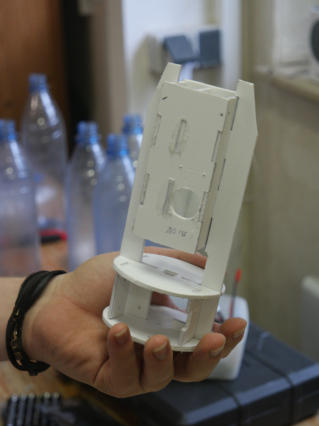
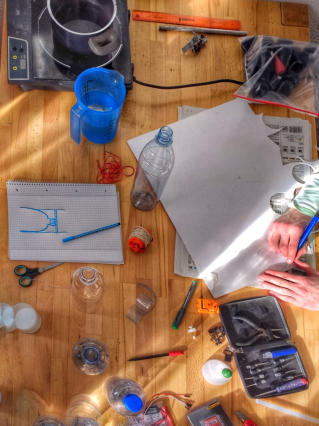
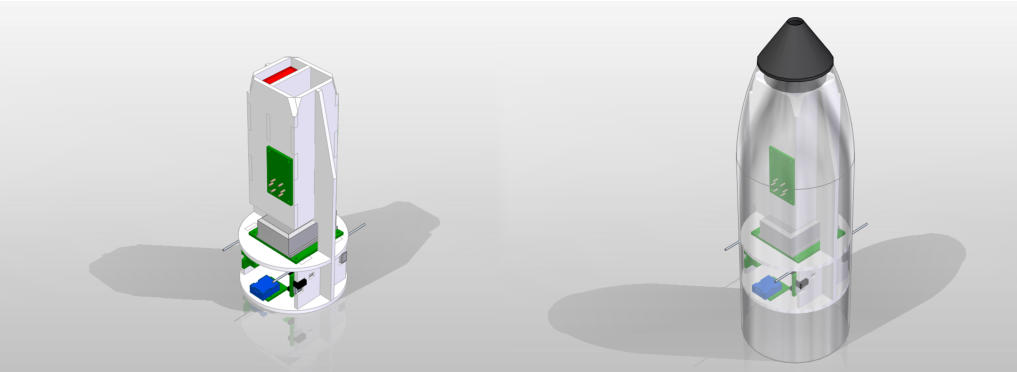
nozzle with
opening for the air duct
power supply
air duct
lower base plate
upper base plate
case
rods
sensors











prototyping
inner structure of the probe
ejection mechanism
CONSTRUCTION OF THE PROBE
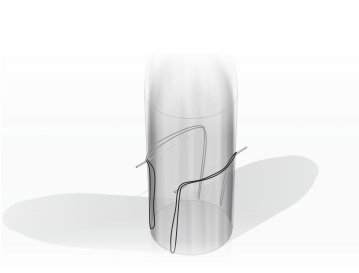
The
separation
of
the
probe
and
the
water
rocket
should
be
realized
with
a
tommy
timer,
just
like
our
regular
parachute
mechanisms
work.
This
was
really
challenging
because
the
rubber
band
had
to
be
deflected
two
times
at
the
probe.
The
timer
itself
is
placed
at
the
ejection mechanism, not at the probe.
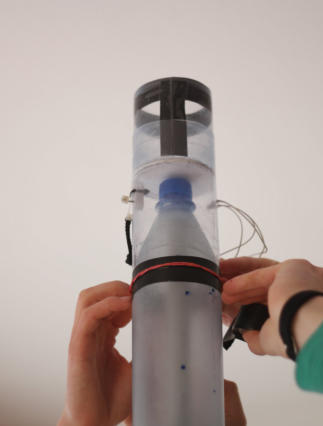
LAUNCH
On
March
26th,
we
were
finally
ready
to
launch
the
rocket
with
the
probe.
The
day
started
with
the
assembly
of
the
last
components
and
some
ground
tests.
In
the
early
afternoon,
we
set
out
to
launch
the
rocket.
But
that
didn‘t
turned
out
well:
Due
to
a
damage
on
one
of
the
bottles,
the
upper
segment
of
the
rocket
exploded
at
14
bar
/
200
psi.
Luckily,
the
damage
wasn‘t
as
bad
as
expected.
Only
the
ejection
mechanism
had
to
be
rebuilt.
And
so
we
were
able
to
start
a
second
attempt of launching the rocket in the evening…
PROJECT EOWR
EARTH OBSERVATION WATER ROCKET


29th March 2017
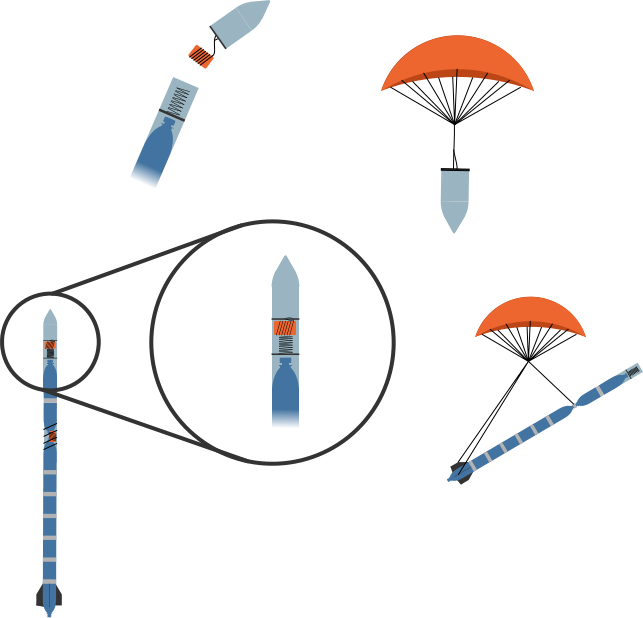
English



Change language:














PROJECT EOWR
EARTH OBSERVATION WATER ROCKET
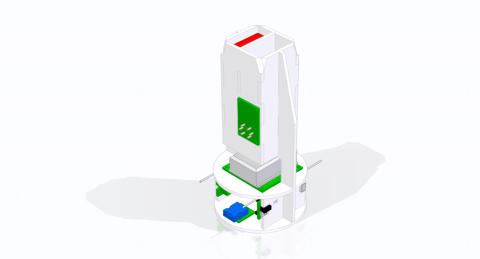
Back
in
October
2016,
two
students
from
DHBW
Stuttgart
reached
out
to
us
because
they
needed
help
with
a
graduation
project.
The
goal
was
to
build
a
water
rocket
which
collects
data
from
the
environment
such
as
particulate
matter,
carbon
dioxide,
atmospheric
humidity
and
much
more.
During
our
first
meeting
in
a
restaurant
we
decided
to
help
them
and
made
the
first
steps
in
developing
a
concept
for
the
project.
But
we
didn‘t
want
to
build
just
a
water
rocket
and
put
the
electronics
in
it
-
we
wanted
to
go
a
step
further
and develop something new:
THE CONCEPT
Fallschirm
Sonde
Feder
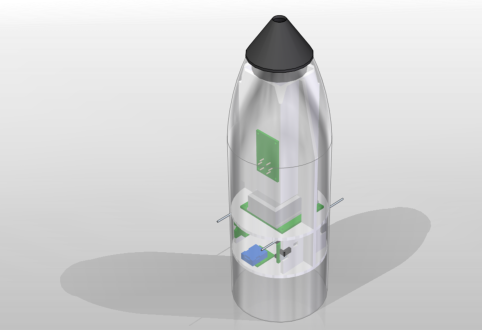
nozzle with
opening for the air duct
power supply
air duct
lower base plate
upper base plate
case
rods
sensors











CONSTRUCTION
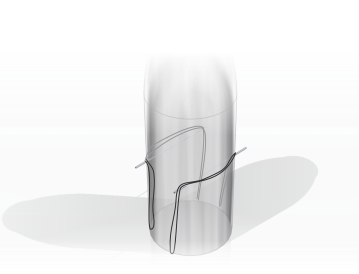


prototyping
inner structure of the probe
ejection mechanism

THE LAUNCH
VIDEO
The
plan
was
to
place
a
mechanism
on
top
of
a
modified
„
Ueberflieger
Mini
Evo
“
Water
Rocket,
which
should
eject
the
upper
part
of
the
rocket
(including
the
electronics)
right
after
reaching
the
apogee.
This
enables
the
sensors
to
collect
much
more
data
than
on
a
regular
flight
without
probe
ejection
since
the
probe
has
a
pretty
large
parachute.
The
separation
of
the
probe
and
the
water
rocket
should
be
realized
with
a
tommy
timer,
just
like
our
regular
parachute
mechanisms
work.
This
was
really
challenging
because
the
rubber
band
had
to
be
deflected
two
times
at
the
probe.
The
timer
itself
is
placed
at
the
ejection
mechanism,
not
at
the probe.
During
the
construction
we
faced
numerous
problems.
The
probe
had
to
have
a
sufficient
spring
in
order
to
separate
it
from
the
rocket.
But
at
the
same
time,
the
mechanism
had
to
be
strong
enough
to
prevent
the
probe
to
be
ejected
before
reaching
the
apogee.
The
connection
between
probe
and
rocket
was
planned
to
consist
of
a
shrunken
bottle
(in
hot
water),
but
unfortunately
it
turned
out
that
the
rubber
bands
pressed
the
probe
so
strong
against
the
connection
that
the
spring
wasn‘t
able
to
eject
the
probe
anymore.
After
some
prototyping,
we
were
able
to
solve
the
problem
with
a
new
connection
which
has
a
stop
point,
so
the
probe
and
the
rocket
were
not
able
to
stick together anymore.
On
March
26th,
we
were
finally
ready
to
launch
the
rocket
with
the
probe.
The
day
started
with
the
assembly
of
the
last
components
and
some
ground
tests.
In
the
early
afternoon,
we
set
out
to
launch
the
rocket.
But
that
didn‘t
turned
out
well:
Due
to
a
damage
on
one
of
the
bottles,
the
upper
segment
of
the
rocket
exploded
at
14
bar
/
200
psi.
Luckily,
the
damage
was
not
as
bad
as
expected.
Only
the
ejection
mechanism
had
to
be
rebuilt.
And
so
we
were
able
to
start
a
second
attempt
of
launching the rocket in the evening…
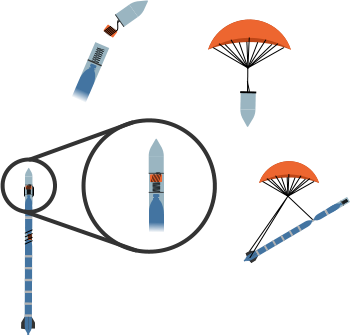
29th March 2017
English



Change language:














HOME
ABOUT US
ROCKETS
LAUNCHES
ARTICLES
TUTORIALS
EDUCATION


HOME
ABOUT US
ROCKETS
LAUNCHES
ARTICLES
TUTORIALS
EDUCATION























































